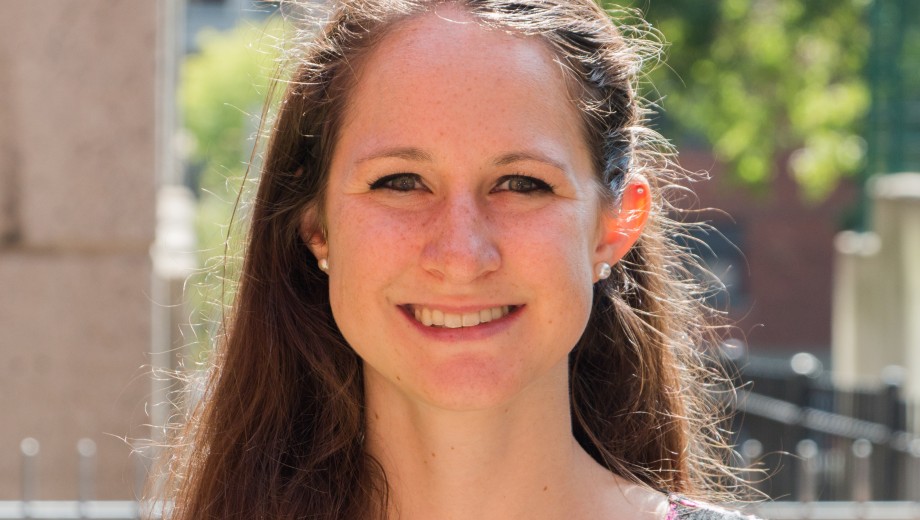Amy Skjerseth, a doctoral candidate in Cinema and Media Studies, researches sound, from its emotional uses in film to lip-syncing and deepfakes. She holds a Franke Dissertation Completion Fellowship for the 2021–22 academic year. Her dissertation in progress, “The Portable Pop Archive in Experimental Cinema: Technological Transformations of Aural Memory,” explores how pop songs in film and music videos trigger emotional responses and memories for viewers. Her publications include the 2019 audio essay “Catching Flies and Catching Memories: The Skin-Crawling Sounds of Yoko Ono’s Fly” and the article “Multiplying Mise-en-Scène: Found Sounds of The Night of the Hunter in Lewis Klahr’s Daylight Moon and Jean-Luc Godard’s Histoire(s) du cinéma” in Film Criticism (2020).
As an undergraduate at the University of Rochester, you received a bachelor’s degree in oboe performance from the Eastman School of Music, as well as one in English. Did that set the pattern for your interest in sound and film?
Absolutely. I started playing violin at six and oboe at 11. I thought I wanted to be a music professor. Midway through college, I was diagnosed with a spinal cord disease. The pain made it really hard to practice and to make reeds. Oboe players make their own reeds to craft their personal sound; it’s a huge creative process, whittling down these pieces of bamboo cane.
I realized I needed to shift my focus to English, so I did a master’s at McGill. In my first semester, I took a course that included Yoko Ono’s film Fly. She and John Lennon also recorded the soundtrack, with Ono doing improvised vocals. She has such an amazing grasp of what you can do with a voice. My first claim in the academic world was that just as close-ups and textures in films appeal to our embodied memories, so can sound.
The idea came from my musical background, especially from making oboe reeds—sitting there for hours whittling away and trying it out between every adjustment. That process of making and personalizing sound has helped me so much to listen closely to the films I study.
So Fly was pivotal for you?
Yes. It’s also part of the second chapter of my dissertation, and I analyze it alongside Ono’s biography in a podcast episode called “The Enduring Voice of Yoko Ono” that I produced for Phantom Power: A Podcast on the Sonic Arts and Humanities.
The film itself is really upsetting.
Absolutely. A woman is lying naked on a bed with flies crawling all over her body. This is familiar territory for Yoko Ono; she also made a film called Rape. Her work has concentrated on feminist topics for a long time.
Both the visual and the aural registers work on spectators in a very deep, embodied way. The music doesn’t have a tonal center. It’s defamiliarizing and not pleasant to listen to, but that’s the point.
During your master’s program, your interest broadened from music to sound in general?
I started to become interested in sound and noise, which is this very subjective valence of sound. What’s noise to one person might not be noise to another. I wrote my master’s research paper on voices and sound effects in horror films.
In your audio essay, you claim viewers might respond completely differently to Fly based on their gender and/or sexual orientation.
That’s super important. Scholars must account for the fact that sound is very personal. Sound and music are floating signifiers that bring up different emotions and memories depending on our backgrounds, identities, and experiences.
Are audio essays becoming more common in sound studies or film studies?
I’m a co-organizer of the Great Lakes Association for Sound Studies and just last night we were talking about this form of scholarship. It hasn’t quite taken off yet. The essay, the article, and the book chapter still take precedence in academic writing.
I think the audio essay format is crucial. If you play an excerpt of a piece of music or a film and describe what you hear in it, the listener can experience it alongside the critic and make their own conclusions.
In the spring you taught a course of your own design, Sound and Scandal: How Media Make Believe, which was a Stuart Tave Teaching Fellowship course. What was on the syllabus?
It’s a cultural history of lip sync, starting with synchronized sound in cinema in the late 1920s. The syllabus includes Singin’ in the Rain [1952], which dramatizes how studios were grappling with not only the technology of sound synchronization, but also a Hollywood stereotype: beautiful women must have beautiful voices. This is something that voice studies has grappled with for a long time—the idea that women’s voices are too high and too whiny. It’s a pervasive thing, vilifying women’s voices by saying that they sound irrational or noisy.
The scandal part of the class was about lip sync as deception—in Beyoncé’s performance during Obama’s inauguration, for example, or the Milli Vanilli scandal. People were upset when they found out they weren’t hearing authentic live voices. That brought us to deepfakes—the way that a voice can be taken apart and manipulated. The concept of lip syncing, of remixing voices and bodies, is a useful heuristic for thinking about how media reinforce cultural stereotypes. My students pointed out a plethora of examples in everything from musicals, music videos, and video games to anime and the Disney Channel. We ended up discussing how we still see racial and gendered stereotypes of lip syncing play out on TikTok and other media today.

